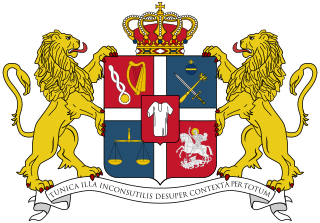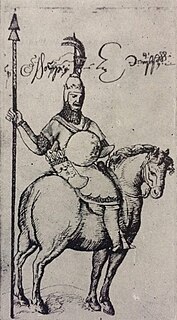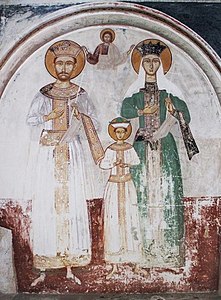Paata Abashidze (Georgian :პაატა აბაშიძე; died 1684) was a member of the Georgian princely family ( tavadi ) of Abashidze, prominent in the politics of the kingdom of Imereti in the 17th century.

Georgian is a Kartvelian language spoken by Georgians. It is the official language of Georgia. Georgian is written in its own writing system, the Georgian script. Georgian is the literary language for all regional subgroups of Georgians, including those who speak other Kartvelian languages: Svans, Mingrelians and the Laz.

Georgia is a country in the Caucasus region of Eurasia. Located at the crossroads of Western Asia and Eastern Europe, it is bounded to the west by the Black Sea, to the north by Russia, to the south by Turkey and Armenia, and to the southeast by Azerbaijan. The capital and largest city is Tbilisi. Georgia covers a territory of 69,700 square kilometres (26,911 sq mi), and its 2017 population is about 3.718 million. Georgia is a unitary parliamentary republic, with the government elected through a representative democracy.

Tavadi was a feudal title in Georgia first applied in the Late Middle Ages usually translated in English as prince or less commonly as duke. The title was designated for dynastic princes who were heads of families, akin to mtavari who had a higher standing.
Paata Abashidze was born to Prince Paata Abashidze and his wife, Princess Gulbudakh Chkhetidze. He succeeded as the head of the house of Abashidze and prince of Saabashidzo in Upper Imereti on the death of his father in 1658. At that time, the kingdom of Imereti was plagued by a civil war in which neighboring Georgian polities were also involved. In 1661, Abashidze allied himself with Vakhtang V, a Mukhranian king of Kartli in eastern Georgia, who pushed for the efforts to install his son Archil as king in Imereti, an endeavor which eventually ended in failure.

Vakhtang V born Bakhuta Mukhranbatoni was the King of Kartli from 1658 until his death, who ruled as a vassal wali for the Persian shah. He is also known under the name of Shah Nawaz, which he assumed on being obliged outwardly to conform to Islam.

The House of Mukhrani is a Georgian family, a branch of the former royal dynasty of Bagrationi from which it sprang early in the 16th century, and received in appanage the domain of Mukhrani located in Kartli, central Georgia. The family has since been known as Mukhran-Batoni, that is, "Princes (batoni) of Mukhrani".

The Kingdom of Kartli was a late medieval/early modern monarchy in eastern Georgia, centered at the province of Kartli, with its capital at Tbilisi. It emerged in the process of a tripartite division of the Kingdom of Georgia in 1478 and existed, with several brief intermissions, until 1762 when Karti and the neighboring Georgian kingdom of Kakheti were merged through a dynastic succession under the Kakhetian branch of the Bagrationi dynasty. Through much of this period of time the kingdom was a vassal of the successive dynasties of Iran, but enjoyed intermittent periods of greater independence, especially after 1747.
Abashidze's influence grew during the reign of Alexander IV, whose sister Darejan, a former wife of ex-king George Gurieli, he married in 1683. Paata Abashidze became a major supporter of Alexander in a renewed civil war in 1684, when George Gurieli attempted to reclaim the crown of Imereti in alliance with Shoshita III, Duke of Racha, Giorgi Lipartiani, regent of Mingrelia, the princes Chijavadze and the nobles of Lechkhumi. The decisive battle at Rokiti ended in Alexander's victory and claimed lives of his major foes, George Gurieli and Shoshita of Racha. Paata Abashidze died soon thereafter of complicated wounds suffered at the battle. [1] [2]
Alexander IV, of the Bagrationi Dynasty, was a king of Imereti from 1683 to 1690 and again from 1691 to 1695.

The Duchy of Racha was an important fiefdom in medieval and early modern Georgia, located in the western province of Racha, in the upper Rioni Valley in the foothills of the Greater Caucasus crest, and ruled by a succession of eristavi ("dukes") from c. 1050 until being transferred to the royal crown in 1789.

The Principality of Mingrelia, also known as Odishi, was a historical state in Georgia ruled by the Dadiani dynasty. Established as an independent Principality in 1557 by Levan I Dadiani as a hereditary mtavari (Prince), it remained independent until it became subject to Imperial Russia in 1803. The principality ultimately came to an end when Prince Niko Dadiani was deposed, and the principality abolished, by Russia in 1867. Prince Niko officially renounced his rights to the throne in 1868.
After Abashidze's death, his widow, Darejan, married Papuna II, Duke of Racha, as her third husband, in 1685. Paata and Darejan had no children. Paata Abashidze's younger brother, Giorgi-Malakia Abashidze, would later become king of Imereti.



